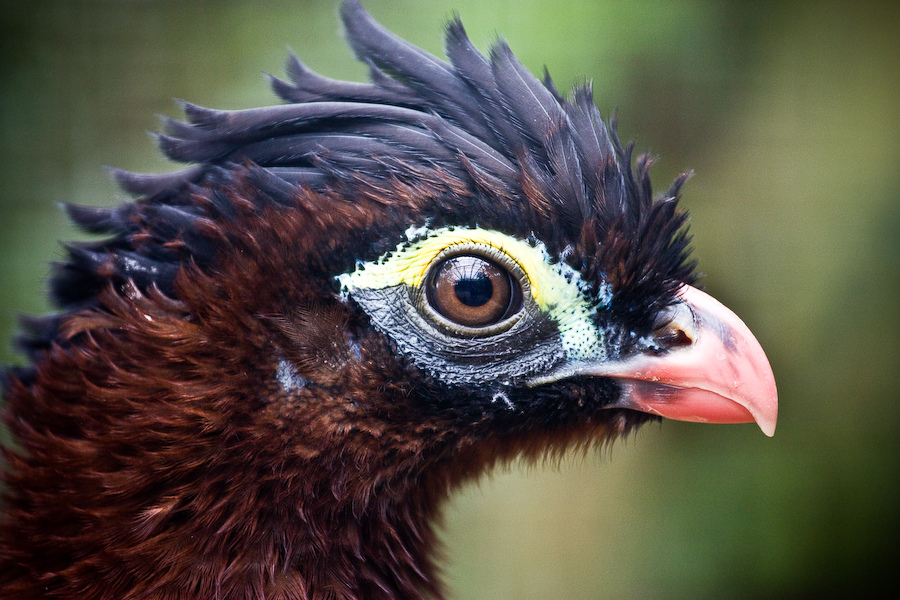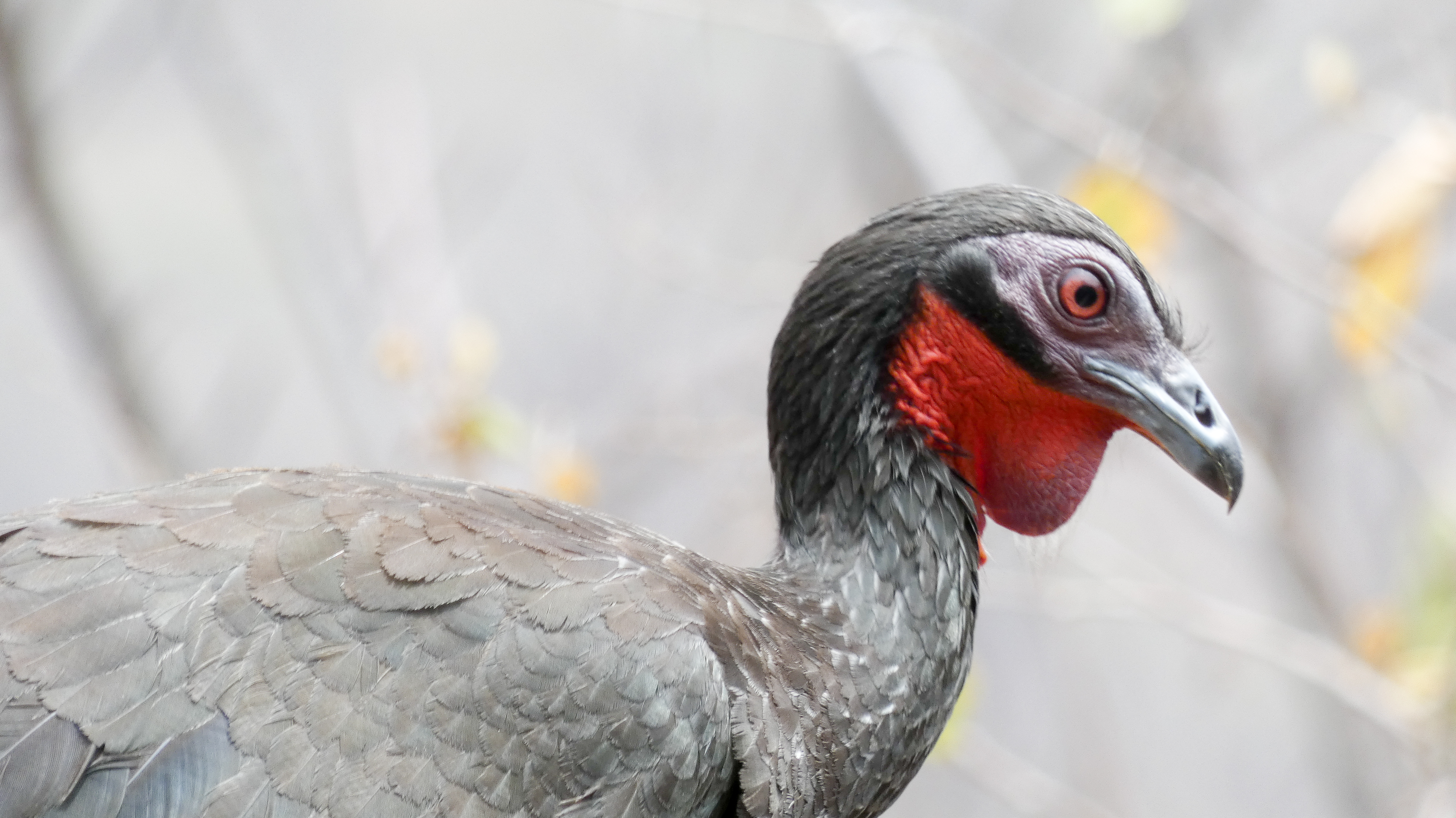|
Cracids
The chachalacas, guans and curassows are birds in the family Cracidae. These are species of tropical and subtropical Central and South America. The range of one species, the plain chachalaca, just reaches southernmost parts of Texas in the United States. Two species, the Trinidad piping guan and the rufous-vented chachalaca occur on the islands of Trinidad and Tobago respectively. Systematics and evolution The family Cracidae was introduced (as Craxia) by the French polymath Constantine Samuel Rafinesque in 1815. The Cracidae are an ancient group related to the Australasian mound-builders. They are sometimes united with these in a distinct order, "Craciformes", but this is not supported by more recent research which suggests that either is a well-marked, basal lineage of Galliformes. Phylogeny Cladogram based on the study by De Chen and collaborators published in 2021. The numbers of species are from the list maintained by Frank Gill, Pamela Rasmussen and David Donsker on beha ... [...More Info...] [...Related Items...] OR: [Wikipedia] [Google] [Baidu] |
Oreophasis
The horned guan (''Oreophasis derbianus'') is a large, turkey-like bird native to Central America. It is the only species in the genus ''Oreophasis''. Taxonomy The holotype specimen of "''Oreophasis Derbianus'' " G.R. GrayGen. Bds., 3, 1844, p.(485). is held in the collections of National Museums Liverpool at World Museum, with accession number D210. The specimen was collected from Volcán de Fuego, Guatemala by Don Joaquin Quinones circa 1843 and came to the Liverpool national collection via the 13th Earl of Derby’s collection which was bequeathed to the people of Liverpool. Phylogeny The horned guan is not a true guan, but merely resembles these birds most in overall shape and color, whereas the horn is more reminiscent of the helmeted curassows. In fact, this species is the only survivor of a very ancient lineage of cracids that has been evolving independently from all other living members of this family for at least 20 million years, and possibly as much as 40 million ye ... [...More Info...] [...Related Items...] OR: [Wikipedia] [Google] [Baidu] |
Cracinae
Curassows are one of the three major groups of cracid birds. They comprise the largest-bodied species of the cracid family. Three of the four genera are restricted to tropical South America; a single species of ''Crax'' ranges north to Mexico. They form a distinct clade which is usually classified as the subfamily Cracinae. Evolution In line with the other 3 main lineages of cracids (chachalacas, true guans, and the horned guan), mt and nDNA sequence data indicates that the curassows diverged from their closest living relatives (probably the guans) at some time during the Oligocene, or c.35–20 mya (Pereira ''et al.'' 2002). This data must be considered preliminary until corroborated by material (e.g. fossil) evidence however. What appears certain from analysis of the molecular data, calibrated against geological events that would have induced speciation is that there are 2 major lineages of curassows: one containing only ''Crax'', and another made up of ''Mitu'' and ' ... [...More Info...] [...Related Items...] OR: [Wikipedia] [Google] [Baidu] |
Penelopina
The highland guan (''Penelopina nigra'') is a species of bird in the family Cracidae. It is found in the highlands of El Salvador, Guatemala, Honduras, southern Mexico, and Nicaragua. Its natural habitat is subtropical or tropical moist montane forest. Its population has declined much in recent times: Listed as a species of Least Concern in 1994, it was uplisted to Near Threatened in 2000 and, as it was determined to be less common than previously believed, to Vulnerable in the 2007 IUCN Red List.See BirdLife International (2004, 2007a,b). Description The highland guan grows to a length of . The plumage of the male is black, the upper parts glossed with green or blue, the underparts rather duller. The iris of the eye is reddish-brown and there is reddish-brown or purplish bare skin around and behind the eye. The beak, the bare skin on the throat, the large wattle, the legs and feet are reddish-orange. The female, by contrast, is black, heavily mottled and barred with reddish-b ... [...More Info...] [...Related Items...] OR: [Wikipedia] [Google] [Baidu] |
Megapode
The megapodes, also known as incubator birds or mound-builders, are stocky, medium-large, chicken-like birds with small heads and large feet in the family Megapodiidae. Their name literally means "large foot" and is a reference to the heavy legs and feet typical of these terrestrial birds. All are browsers, and all but the malleefowl occupy wooded habitats. Most are brown or black in color. Megapodes are superprecocial, hatching from their eggs in the most mature condition of any bird. They hatch with open eyes, bodily coordination and strength, full wing feathers, and downy body feathers, and are able to run, pursue prey, and in some species, fly on the same day they hatch. Description Megapodes are medium-sized to large terrestrial birds with large legs and feet with sharp claws. The largest members of the clade are the species of '' Alectura'' and '' Talegalla''. The smallest are the Micronesian scrubfowl (''Megapodius laperouse'') and the Moluccan scrubfowl (''Eulipoa ... [...More Info...] [...Related Items...] OR: [Wikipedia] [Google] [Baidu] |
Pipile
The piping guans are a bird genus, ''Pipile'', in the family Cracidae. A recent study, evaluating mtDNA, osteology and biogeography data concluding that the wattled guan belongs in the same genus as these and is a hypermelanistic piping guan. Thus, ''Pipile'' became a junior synonym of ''Aburria'', though this conclusion was not accepted by the South American Checklist Committee, or evaluated by the IOC, so the classification remains in Pipile. The same results also showed that the light-faced taxa ''pipile, cumanensis'' and ''cujubi'' are not, as was sometimes suggested, conspecific. However, free interbreeding between '' A. cujubi'' and '' A. cumanensis grayi'' in eastern Bolivia, creating a "hybrid swarm", casts doubt on this conclusion for the two species named. It was possible to confidently resolve that the white-faced species form a clade, whereas the more basal black-faced forms are of less certain relationship. Possibly, the black-fronted piping guan is the basalm ... [...More Info...] [...Related Items...] OR: [Wikipedia] [Google] [Baidu] |
Aburria
The wattled guan (''Aburria aburri'') is a species of bird in the family Cracidae. It is a fairly large black cracid with blue-based, black-tipped beak and a long, red-and-yellow wattle. It is found in Colombia, Ecuador, Peru, and Venezuela. Its natural habitats are subtropical or tropical moist lowland forest and subtropical or tropical moist montane forest. The wattled guan is a fairly shy species that is mostly seen when it perches on the outer edge of the canopy from a distance. Like many tropical forest birds, it is heard more often than seen. It is threatened by habitat destruction and the IUCN has assessed its conservation status as being "near threatened". Description The wattled guan is recognisable by the elongated red and yellow fleshy wattle that dangles from its throat. It is a large bird with a long tail, about long and weighing between . The plumage is black, the beak is blue and the feet are flesh-coloured. Distribution and habitat The wattled guan is endemic ... [...More Info...] [...Related Items...] OR: [Wikipedia] [Google] [Baidu] |
Penelope (genus)
''Penelope'' is a bird genus in the family Cracidae consisting of a number of large turkey-like arboreal species, the typical guans. The range of these species is in forests from southern Mexico to tropical South America. These large birds have predominantly brown plumage and have relatively small heads when compared to the size of their bodies; they also bear a characteristic dewlap. Body lengths are typically 65 to 95 centimeters. Most of the genus members have a typically raucous honking call. A number of the genus members are endangered species and at least one is critically endangered, usually due to tropical deforestation and hunting. In the case of several species the estimated populations are as low as a few 1000 mature birds, spread over a considerable area. Because of the scarcity of many of the genus members and also due to the habitat being often in deep or high altitude forests, little is known about some of the species habits and reproduction; in fact, some ... [...More Info...] [...Related Items...] OR: [Wikipedia] [Google] [Baidu] |
Chamaepetes
''Chamaepetes'' is a genus of bird Birds are a group of warm-blooded vertebrates constituting the class Aves (), characterised by feathers, toothless beaked jaws, the laying of hard-shelled eggs, a high metabolic rate, a four-chambered heart, and a strong yet lightweig ... in the family Cracidae. It contains the following species: References Bird genera Taxonomy articles created by Polbot {{Galliformes-stub ... [...More Info...] [...Related Items...] OR: [Wikipedia] [Google] [Baidu] |
Central Atlas Für Zoologische Gärten (Taf
Central is an adjective usually referring to being in the center of some place or (mathematical) object. Central may also refer to: Directions and generalised locations * Central Africa, a region in the centre of Africa continent, also known as Middle Africa * Central America, a region in the centre of America continent * Central Asia, a region in the centre of Eurasian continent * Central Australia, a region of the Australian continent * Central Belt, an area in the centre of Scotland * Central Europe, a region of the European continent * Central London, the centre of London * Central Region (other) * Central United States, a region of the United States of America Specific locations Countries * Central African Republic, a country in Africa States and provinces * Blue Nile (state) or Central, a state in Sudan * Central Department, Paraguay * Central Province (Kenya) * Central Province (Papua New Guinea) * Central Province (Solomon Islands) * Central Province, Sri La ... [...More Info...] [...Related Items...] OR: [Wikipedia] [Google] [Baidu] |
International Ornithologists' Union
The International Ornithologists' Union, formerly known as the International Ornithological Committee, is a group of about 200 international ornithologists, and is responsible for the International Ornithological Congress and other international ornithological activities, undertaken by its standing committees. International Ornithological Congress The International Ornithological Congress series forms the oldest and largest international series of meetings of ornithologists. It is organised by the International Ornithologists' Union. The first meeting was in 1884; subsequent meetings were irregular until 1926 since when meetings have been held every four years, except for two missed meetings during and in the immediate aftermath of the Second World War World War II or the Second World War, often abbreviated as WWII or WW2, was a world war that lasted from 1939 to 1945. It involved the World War II by country, vast majority of the world's countries—including all ... [...More Info...] [...Related Items...] OR: [Wikipedia] [Google] [Baidu] |
Pamela Rasmussen
Pamela Cecile Rasmussen (born October 16, 1959) is an American ornithologist and expert on Asian birds. She was formerly a research associate at the Smithsonian Institution in Washington, D.C., and is based at the Michigan State University. She is associated with other major centers of research in the United States and the United Kingdom. Rasmussen's early research investigated South American seabirds and fossil birds from North America. She later specialised in Asian birds describing several new species and clarifying the status of others, particularly white-eyes and owls. More recently, she has been involved in large scale collaborations looking at patterns of global biodiversity, and has assessed the taxonomic status of South Asian vultures. She was the main author of '' Birds of South Asia: The Ripley Guide'', a landmark publication due to its greater geographical and species coverage compared to its predecessors. As a result of her study of museum bird specimens when re ... [...More Info...] [...Related Items...] OR: [Wikipedia] [Google] [Baidu] |
_(6436435841)_(cropped).jpg)





.jpg)
